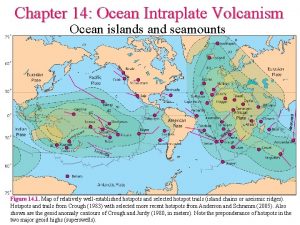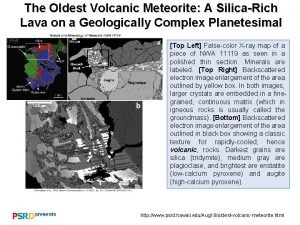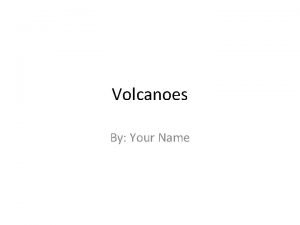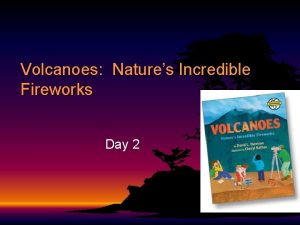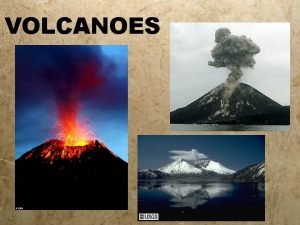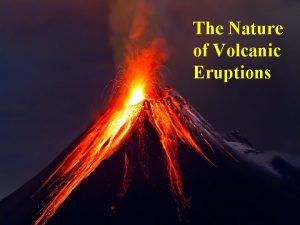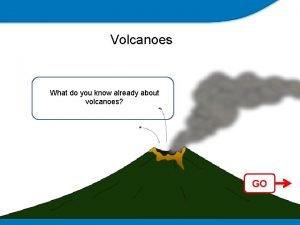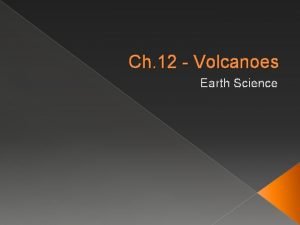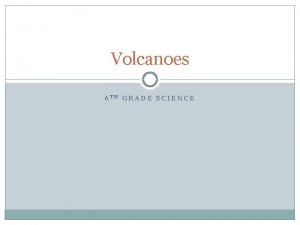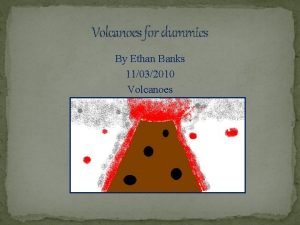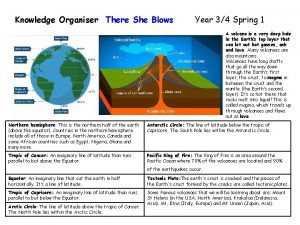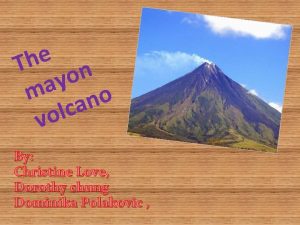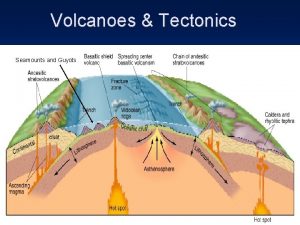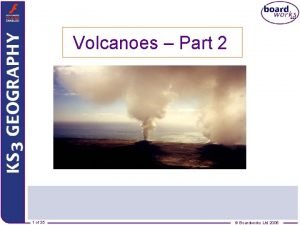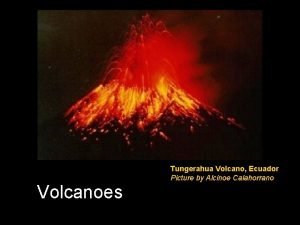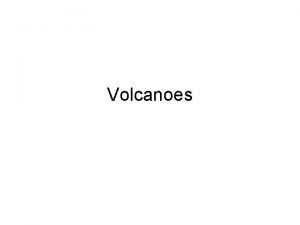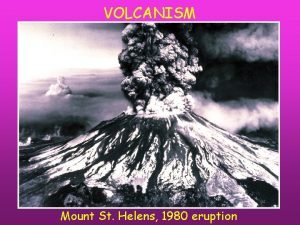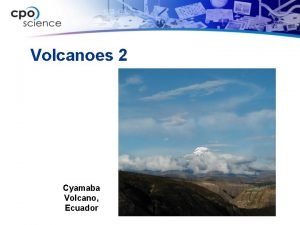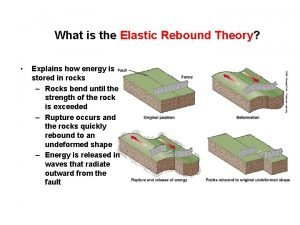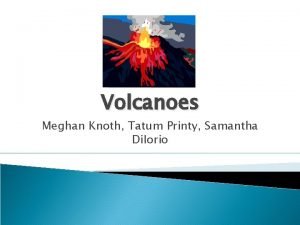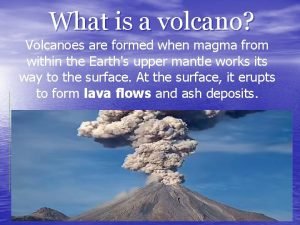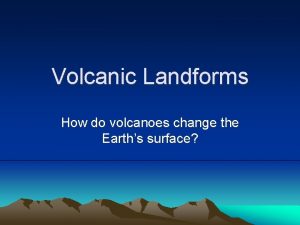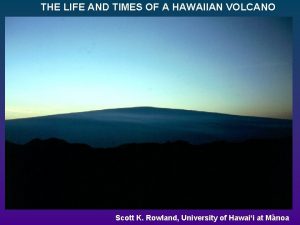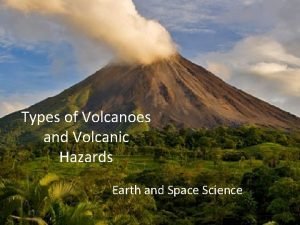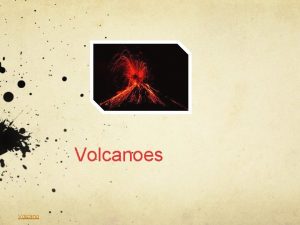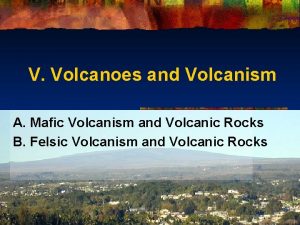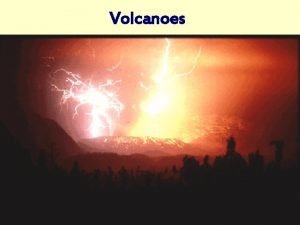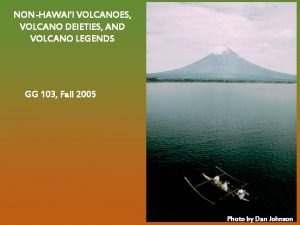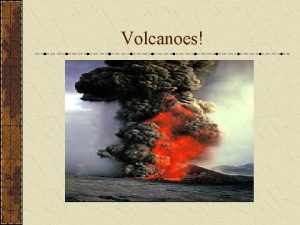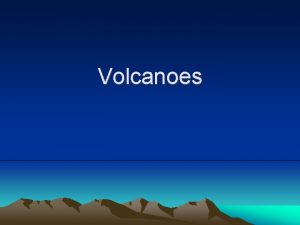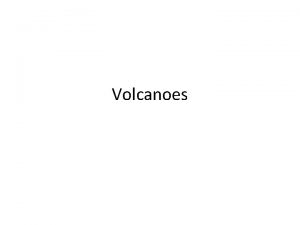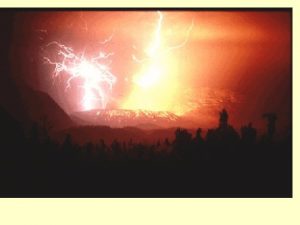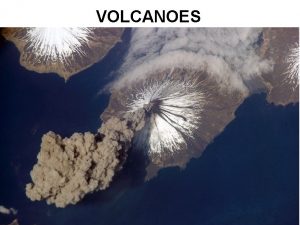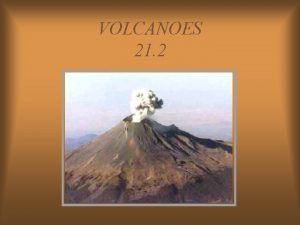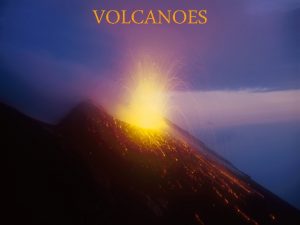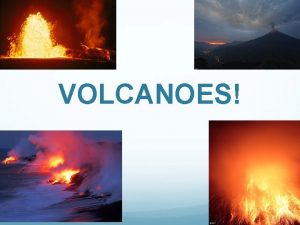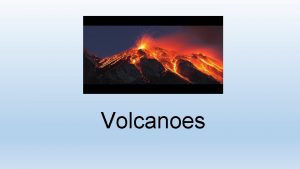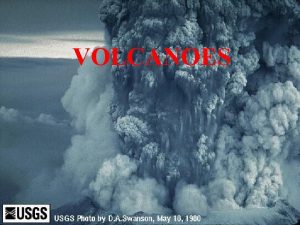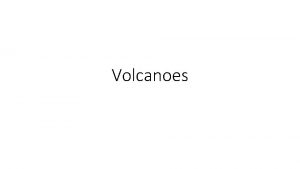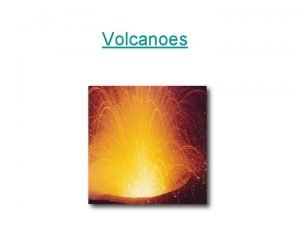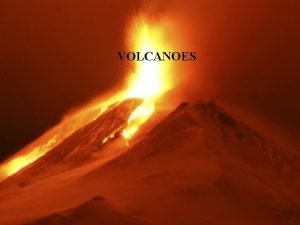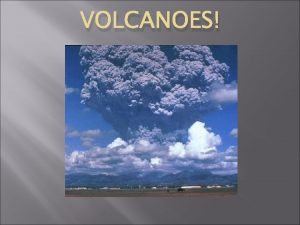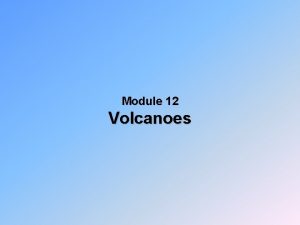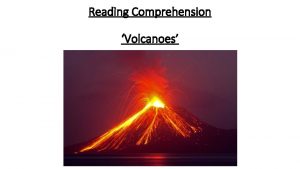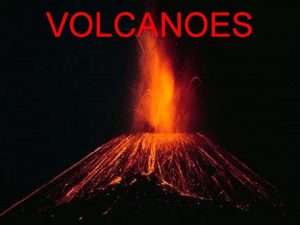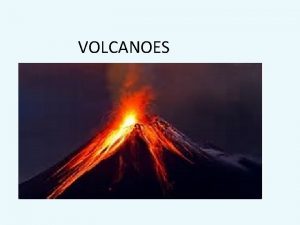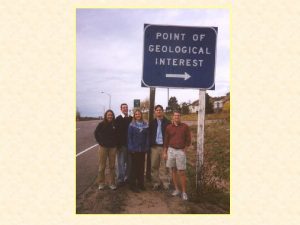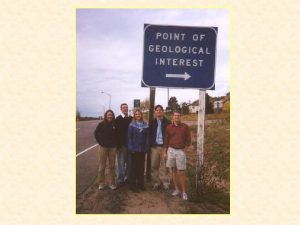Volcanoes What is a Volcanism volcano Nature origin

































- Slides: 33

Volcanoes What is a Volcanism & volcano? Nature & origin of volcano Causes of volcanism Products of volcanism types of Volcanoes Benefits

What is a volcanism & volcano ? A volcano is an opening, or rupture, in the surface or crust of the Earth or a planetary mass object, which allows hot lava, volcanic ash and gases to escape from the magma chamber below the surface.

Where do volcanoes erupt? A) In the middle of the earth’s plates, hotspots. B) Near the edges of the earth’s plates. C) Subduction and rift zones.

Volcanoes result from magma rising off the melting subducted plate. . .

Oceanic Ridge Volcanoes .

Nature & origin of volcano Active volcano Dormant volcano Extinct volcano

Active volcano Currently erupting Recently erupted 10, 000 years

Dormant volcano Not erupted recently but in future Increasing earth temp.

Extinct volcano Erupted long time ago Unlikely to erupt again Massive erosion

Causes of volcanism Gas in volcanic magma Magma viscosity

Why do volcanoes erupt? Hot, melted rock (magma) deep within the earth becomes lighter as it heats up. Because it is lighter than solid rock it rises until it pushes to the surface of the earth. A volcanic eruption occurs!

Gas & magma viscosity 1% to 9% Decrease in pressure Increase in Viscosity Felsic (silica & low cooling temp) Mefic (low viscosity & high temp) High viscosity & more pressure

Products of volcanism Types of lava ØBasaltic lava ØAndesite lava ØRhyolitic lava

Basaltic lava Low viscosity & temp. Pahoehoe(high speed & thin sheet ) Aa( cooler material inside & hot material outside) Scoria & columnar jointing (shrinkage ) Lava tubes

Pahoehoe: Lava with a ropelike surface texture due to partial cooling as the lava flowed. Relatively hot, low viscosity lava.

Aa: Blocky, rough lava flow. Due to high viscosity lava that flowed pushing chunks of solid and semi-solid blocks.

Lava tube: A tube formed by cooling and solidifying of the lava walls while fluid lava continued to flow inside.

Andesite lava Intermediate flow Near to vent Scoria but less sheets

Rhyolitic lava High viscosity Mostly Cools with earth Explosive at earth Pumice

Pyroclasts & tephra Fire fragments Cooling in air Volcanic dust (1000 th of milimeter ), volcanic ash (less than 2 mm) Cinders (2 to 64 mm) Volcani boomb (more than 64 mm) Volcanic tuff (cemented)

Ash: tephra that is finer than 2 mm in diameter.

Lapilli: from 2 mm to 64 mm in diameter. Blocks: hard fragments greater than 64 mm in diameter.

Bombs: soft, partially melted fragments greater than 64 mm in diameter.

Volcanic mud flows Mixing with water (lahar ) Finest ash to 100 ton boulders Near ice &High speeds

Landforms Volcanic cone & crater Effusive eruption (quiet , non explosive eruptions) Caldera (a depression ) Fissuries eruptions Subaqueous eruptions (quiet & effusive) Pyroclatic (gass rich, explosives) Volcanic dome (felsic material) Culminating eruption (highly explosive , caldera) Ash flow eruptions

Types of volcnos Shield volcano Composite Cinder cone

Shield volcanoes: dominated by lava flows. Muana Loa Volcano – the world’s largest volcano.

Typical slopes approximately 15 degrees. Lava flows downslope, away from a central vent or a series of vents. Low viscosity lava forms fountains of lava flowing from vents near the volcano summit. The lava flows easily down the gentle slopes…. reaching the ocean during some eruptions. USGS

Cinder cones: dominated by pyroclastics. Forms an isolated conical mound of tephra. Photograph by J. P. Lockwood on 1 December 1975

Internally constructed entirely of layers of pyroclastic deposits (blocks, bombs, lapilli). Typical angles: 30 to 40 degrees Slopes are steep, at angle of repose. Angle of repose: the natural maximum angle that a pile of loose, unconsolidated material will form.

Stratovolcanoes: mixture of lavas and pyroclastics.

Stratovolcanoes Volcanoes that alternate between periods of lava flows (constructive phase) and periods of explosive eruptions (destructive phase). Commonly called “composite volcanoes” because they are made up of both lava and pyroclastic deposits. Steep slopes, at angle of repose or greater. © Noemi Emmelheinz 2001

Benefits of volcanoes Eruption of gases Information of interor Equilibrium Geothermal heat
 Intraplate volcanism
Intraplate volcanism Volcanism
Volcanism A dome mountain forms when _____.
A dome mountain forms when _____. Volcanoes nature's incredible fireworks
Volcanoes nature's incredible fireworks Chapter 8 earthquakes and volcanoes
Chapter 8 earthquakes and volcanoes Factors affecting volcanic eruption
Factors affecting volcanic eruption How are volcanoes classified?
How are volcanoes classified? Magma
Magma What do you already know about volcanoes?
What do you already know about volcanoes? Volcanoes of italy map
Volcanoes of italy map Ring of fire volcanoes
Ring of fire volcanoes How are volcanoes formed
How are volcanoes formed Name volcanoes
Name volcanoes Paboeboe
Paboeboe Volcanoes knowledge organiser
Volcanoes knowledge organiser Differentiate active and inactive volcanoes
Differentiate active and inactive volcanoes Three main ways volcanoes are created
Three main ways volcanoes are created Magma chamber
Magma chamber Active volcanoes map
Active volcanoes map Most volcanoes occur __________. *
Most volcanoes occur __________. * Where are volcanoes
Where are volcanoes Cotapoxi
Cotapoxi Elastic rebound
Elastic rebound Types of volcanoes
Types of volcanoes Shield volcanoes
Shield volcanoes How are volcanoes formed
How are volcanoes formed How do volcanoes change landforms
How do volcanoes change landforms How are volcanoes made
How are volcanoes made What is constructive forces
What is constructive forces A'a hawaiian
A'a hawaiian Types of volcanoes
Types of volcanoes Origin purpose content
Origin purpose content Nature origin purpose
Nature origin purpose Nature nature controversy
Nature nature controversy
